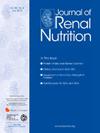高淀粉抗性淀粉对 G3a-G4 期慢性肾病患者肠道微生物群和尿毒症毒素水平的影响:随机试验。
IF 3.2
3区 医学
Q2 NUTRITION & DIETETICS
引用次数: 0
摘要
研究目的本研究旨在确定在G3a-G4期慢性肾脏病(CKD)患者体内补充16周Hi-maize 260抗性淀粉对肠道微生物群、尿毒症毒素(硫酸吲哚酯和硫酸对甲酚酯)、炎症和氧化应激指标以及血管功能的影响:这是一项双盲、安慰剂对照、平行臂随机对照试验。68 名 G3a-G4 期慢性肾脏病患者被随机分配到抗性淀粉与常规护理或安慰剂与常规护理中。患者参加了四次测试:两次基线访问,以及 8 周和 16 周的随访。在第 1 次或第 2 次就诊以及第 8 周和第 16 周时收集空腹血样、静息肱动脉血压和中心血压以及动脉僵硬度。在基线和第 16 周收集粪便样本以分析微生物成分。基线检查结束后,对患者进行随机分组:结果:接受抗性淀粉治疗的患者在第 16 周时对甲酚硫酸盐含量有所下降。结果:接受抗性淀粉治疗的患者在第 16 周时对甲酚硫酸盐含量降低,这与基线和第 16 周时微生物 α 多样性的降低有关(Chao1 p=0.014,Shannon p=0.017,PD p=0.046,Simpson p=0.017),也与 Subdoligranulum(p=0.16周后,微生物β多样性和其他生物标志物或血管功能标志物没有发生变化:对 G3a-G4 期慢性肾脏病患者补充抗性淀粉 16 周后,微生物组成发生了变化,这与对甲酚硫酸盐的显著降低有关。本文章由计算机程序翻译,如有差异,请以英文原文为准。
Effects of High Amylose-Resistant Starch on Gut Microbiota and Uremic Toxin Levels in Patients With Stage-G3a-G4 Chronic Kidney Disease: A Randomized Trial
Objective
This study was designed to determine the effect of 16 weeks of supplementation with Hi-maize 260 resistant starch (RS) on the gut microbiota, uremic toxins (indoxyl sulfate and p-cresyl sulfate [PCS]), markers of inflammation, and oxidative stress along with vascular function in patients with stage G3a-G4 chronic kidney disease (CKD).
Design and Methods
This was a double-blind, placebo-controlled, parallel-arm, randomized controlled trial. Sixty-eight patients with stage-G3a-G4 CKD were randomized to either RS with usual care or placebo and usual care. Patients attended four testing sessions as follows: two baseline (BL) visits and follow-up visits at 8 and 16 weeks. Fasting blood samples, resting brachial and central blood pressures, along with arterial stiffness, were collected at visits (1 or 2) and weeks 8 and 16. A stool sample was collected for analysis of microbial composition at BL and week 16. Patients were randomized after the BL visits.
Results
Patients receiving the RS had a reduction in PCS at week 16. This reduction was associated with a decrease in microbial α-diversity between BL and week 16 (Chao1 P = .014, Shannon P = .017, phylogenetic diversity P = .046, and Simpson P = .017) as well as increases in Subdoligranulum (P = .03) and Oscillospiraceae Unclassified Clostridiales Group 002 (P = .02) and decreases in Bacteroides (P = .009).There were no changes in microbial beta diversity and other biomarkers or markers of vascular function following the 16-week period.
Conclusion
Sixteen weeks of supplementation of RS in patients with stage-G3a-G4 CKD led to changes in microbial composition that were associated with a significant reduction in PCS.
求助全文
通过发布文献求助,成功后即可免费获取论文全文。
去求助
来源期刊

Journal of Renal Nutrition
医学-泌尿学与肾脏学
CiteScore
5.70
自引率
12.50%
发文量
146
审稿时长
6.7 weeks
期刊介绍:
The Journal of Renal Nutrition is devoted exclusively to renal nutrition science and renal dietetics. Its content is appropriate for nutritionists, physicians and researchers working in nephrology. Each issue contains a state-of-the-art review, original research, articles on the clinical management and education of patients, a current literature review, and nutritional analysis of food products that have clinical relevance.
 求助内容:
求助内容: 应助结果提醒方式:
应助结果提醒方式:


